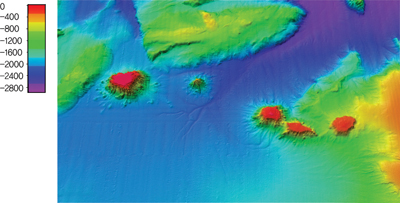- Dokdo in the East Sea
- Educational material
- Junior High School Version
Dokdo in the East Sea
Table of Contents Open Contents
- Dokdo: Korean Territory
- Dokdo: Keeper of the East Sea!
- Ulleungdo and Dokdo: We’re Siblings!
- Dokdo’s Been Korean Land Since the Three Kingdoms Period!
- Dokdo’s Been Korean Land in the Modern Era!
- Dokdo Appears Even on Old Maps!
- Mission: Protect Dokdo!
- Others Have Known, Too ... That Dokdo Is Korean Land!
- Dokdo Is Korean Land Even on Old Japanese Maps!
- Japan’s Claims to Dokdo Are False!
2 Chapter Reference
1 Dokdo’s Formation
Dokdo is estimated to have formed from volcanic activity about 2.5 to 4.6 million years ago. Dokdo was formed by huge amounts of hardened lava from the seabed some 2,000 meters below sea level, and gradually increasing in elevation over time.
The first phase of the formation began about 2.7 to 4.5 million years ago, with the development of the base.
The second phase took place about 2.5 to 2.7 million years ago. The volcanic lava eventually broke the ocean surface, and the exposed lava was cooled by rain and ocean waters to form the island’s current shape. Thus, the underwater mountain finally extended above the waterline, and continuous eruptions resulted in an island base.
The third and final phase began about 2.5 million years ago, when eruptions caused small amounts of viscous lava to flow out, eventually forming a dome shape over the base. The singular Dokdo began separating into two as a result of erosion and took its current shape some 2.1 million years ago as wind and water continued to chip away at the island.
2 Dokdo’s Topography
In a line from the east, Mt. Isabu, Mt. Simheungtaek, Dokdo, Mt. Anyongbok, and Ulleungdo form a mountain range. These large cone-shaped underwater mountains formed 2,000 meters below sea level. The highest peak on Dokdo is found on Seodo, about 168.5 meters above sea level.
3 Dokdo’s Ecology
Due to its volcanic origins, Dokdo is not a suitable environment for plant life. In addition, the surface soil of the island is rather dry, as any rainwater quickly runs off its steep slopes. Despite such an environment, there are over to 50 to 60 different types of plant species found on Dokdo. The plant species mostly consist of grasses, such as Miscanthus and Calamagrostis. Herbs such as dandelion, oxalic, foxtail, plantain, and Haeguk can be found, as well as such shrubs and trees as thunbergii, red thorn berry, and camellia.
Dokdo serves an important function as a stopover point for migratory birds, and 22 different species have been observed on the island, including the petrel, shearwater, black-tailed gull, kestrel, osprey, yellow thrush, white gull, and flycatcher. Among these, the petrel, shearwater, and black-tailed gull have been designated as natural monuments.
Located south of the Polar Front, Dokdo is primarily affected by cold currents. Areas where cold and warm currents meet attract a variety of marine life, forming what is called a Golden Fishery, or rich fishing grounds. Seaweed, kelp, and laver are found on every rock surface, and squid, saury, yellowtail, blowfish, parrot fish, and flat fish are primarily found in the area. In addition, shellfish such as abalone, turban shell, and mussels populate the area, as do sea cucumber, shrimp, and red crab.
In 1982, Dokdo was designated as Natural Monument No. 336 “Dokdo Algae Breeding Grounds” by the Cultural Heritage Administration of Korea. Its designation changed to “Dokdo Natural Protected Area” in 1999. Dokdo was then designated as a “Special Island” by the Ministry of Environment in September 2000, and efforts have been made since for the preservation of the natural environment and ecosystems.
4 Deep Ocean Waters of the East Sea
Deep Ocean Water refers to water found 200 or more meters below the surface, too deep to receive sunlight. The DOW originates in Greenland and takes around 2,000 years to circulate through the Atlantic, Pacific, and Indian oceans one time.
When the circulating waters reach the Greenland Glaciers, they become extremely cold, increasing the volume of the DOW. This water reaches down 200 meters below the surface with temperatures around 2 degrees Celsius. The DOW does not mix with the warmer waters above, and they remain separate, similar to a mixture of oil and water. The DOW is rich in nutrients and minerals and is known to be clean and safe from contamination Due to its slow current, the DOW takes around 2,000 years to circulate around the world one time.
The United States and Japan began to take interest in Deep Ocean Water approximately 30 to 40 years ago, and recent discoveries and uses in the beverage, cosmetic, and medical industries have increased its significance as a resource. Currently, the DOW is being developed and marketed in Ulleungdo.












